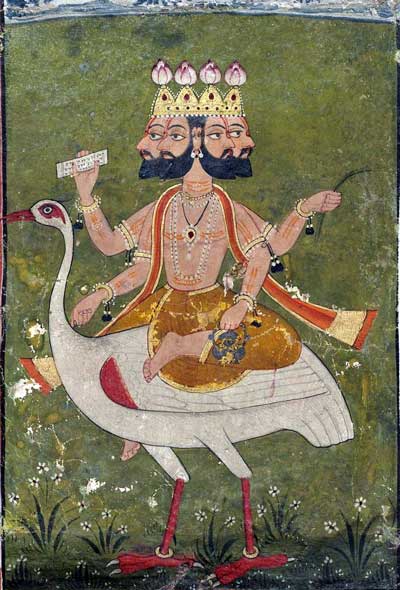
Who is Brahma?
In Hinduism, Brahmā (Sanskrit: meaning "swelling" or "expansion") is "God" in his manifestation as Creator of the universe. Brahmā is part of the Trimurti (the Hindu Trinity) alongside Vishnu and Shiva, and represents the creative aspect of Brahman, the supreme cosmic spirit in Hindu philosophy. While these two terms derive from the same Sanskrit root brh (to grow great or strong), they should not be confused, as Brahman refers to the ineffable ground of all being, while Brahmā is the deity which personifies its creative power. According to the Brahmā Purāņa, he is the father of Manu, and from Manu all human beings are descended. In the Rāmāyaņa and the Mahābhārata, he is often referred to as the progenitor or great grandsire of all human beings.
No longer widely worshiped in modern Hinduism, Brahmā is still important in Hindu mythology, and two temples in India continue to honor him today. Brahmā is said to live in Brahmapura, a mythical city located on Mount Meru. As creator of the world, Brahmā is considered to be the father of Dharma (the way of truth) who bestows knowledge upon both human beings and gods.
Brahma's mind born sons are the seers Marici, Atri, Angiras, Pulastya, Pulaha, Kratuj, Pracetas, Vashishta, Bhrgu and Narada. From Brahma's body came his nine sons Daksa, Dharma, Kama, Anger, Greed, Delusion (Maya), Lust, Joy, Death and Bharata and one daughter called Angaja.
In order to create the world and produce the human race, Brahma made a goddess out of himself. One half was woman and the other half was man. Brahma called the woman Gayatri, but she also became known by many other names such as Saraswati.
Brahma has four heads, but used to have five. The four extra heads appeared when Gayatri was very ashamed with Brahma's love for her and tried to escape from his gaze. The tremendous tapas that Brahma had practiced for the purpose of creation was entirely annihilated through his desire to unite with his daughter. One head was lost later when Brahma lied to Vishnu and thus caused Shiva to become very angry.
The four Veda's are said to have sprung from his heads. In the Life of Ganga, Brahma advised Bhagiratha to ask the help of Shiva in containing the power of Ganga (goddess of the Ganges river).
Origins
There are numerous accounts of Brahmā's origin in the Hindu scriptures, which offer divergent versions of his beginnings. According to the widely read and popular Puranas, Brahmā was self-born at the beginning of the universe from the lotus that grows out of Vishnu's navel (consequently, Brahmā is sometimes called Nabhija or "born from the navel"). Another legend says that Brahmā created himself by first creating water. Into the water he deposited a seed that later became the golden egg or Hiranyagarbha. From this golden egg, Brahmā the personified creator was born, with the egg's remaining materials expanding to form the Universe (as a result, he is also known as Kanja, or "born in water").
In the Sapatha Brahmana, Brahmā is said to have come into being from the merger of the human priesthood with fire, the element which had long been the focus of the Vedic rituals. This suggests that Brahmā's historical origins are closely related to Vedic sacrifices. In the Upanishads, Brahmā gradually supplants Prajpati (or the "Lord of Creatures," the most commonly recognized creator god in the Vedas) as the initial creator, assuming most of Prajpati's characteristics. The Mundaka Upanishad explains that "Brahmā arose as first among the gods, the maker of the universe, the protector of the world" (1.1.1). Such descriptions had previously been given to Prajpati in the Vedas.
Role as Creator god
In Hinduism, Brahmā is called the creator god that provided the causal force from which the universe was formed. At the beginning of the process of creation, Brahmā is said to have created ten Prajapatis (not to be confused with the deity of the same name), who are believed to be the fathers of the human race. The Manusmriti enumerates them as Marichi, Atri, Angirasa, Pulastya, Pulaha, Kratu, Vasishtha, Prachetas (or Daksha), Bhrigu, and Narada. Brahman is also said to have created the seven great sages or the Saptarishi to help him create the universe. However since these sons were born out of his mind rather than body, they are called Manas Putras or "mind-sons." This latter legend no doubt illustrates why Brahmā is so frequently related to the mind and understanding. Brahmā is said to have a vast capacity for wisdom, and is responsible for all knowledge which has been bestowed upon human beings and gods.
Early Hindu folklore explains that when nothing exists, Brahmā slumbers; when he exhales, the universe comes into existence. After staying awake for a day, two billion years in the human conception of time, Brahmā inhales and falls asleep again, ending the universe as it is known, but taking all its constituents back into himself. In later literature, Brahmā becomes a more purposeful creator, rendering the gods (Agni, Soma, Surya, and so forth) and assigning them to their correct stations in the heavens and upon the earth. Since Brahmā is responsible for all creation, he is thereby also responsible for the creation of every god in the Hindu tradition, including those more powerful than himself. This has been regarded as his greatest contribution. However, Brahmā has apparently drifted out of importance mythologically until his next inhalation, slumber and recreation.
Worship
The worship of Brahmā has declined in popularity due to Hindu preference for other deities. Several myths and legends have attempted to elucidate the eclipse of Brahmā as a revered god. For example, the Puranas explain that Shiva, in addition to removing Brahmā's fifth head, also decreed there be no proper worship in India for the "unholy" Brahmā. Another tale states that the Hindu gods Vishnu and Brahmā once approached Shiva and requested to find his beginning and end. Vishnu was given the task of finding his end, and Brahmā the beginning. Each took their journey, and neither could find their appointed destination. Vishnu, satisfied with the power of Shiva, approached the latter god and bowed down before him, honoring him as a true manifestation of Brahman. Brahmā, however, did not submit to Shiva so easily. As he was going upward to find Shiva's beginning, he encountered a kaitha flower, a plant very dear to Shiva. His ego forced him to ask the flower to bear false witness that he had indeed found Shiva's beginning. When Brahmā told his tale, Shiva, the "all-knowing," was angered by the former's ego. Shiva thus cursed him that no being in the three worlds would worship Brahmā.
These legends reflect the declining patterns of worship given to the Brahmā throughout history. Whether the legends reflected the reality of Brahmā's declining popularity, or created the reality is open to debate.
While Vishnu and Shiva continue to be worshipped today, Brahmā is almost totally ignored. India has only two temples dedicated specifically to Brahmā, in contrast to the thousands of temples dedicated to both of the other deities in the Trimurti. The most famous temple to Brahmā is located at Pushkar in Rajasthan state. Once a year, on the full moon night of the Hindu lunar month of Kartika (October-November), a festival is held in Brahmā's honor. Thousands of pilgrims come to bathe in the holy lake adjacent to the temple, an action which is said to eradicate all sins. The other temple is located in the temple town of Kumbakonam (Thanjavur District), Tamil Nadu. Here, regular pujas are held for Brahmā, and during Navrathris this temple comes to life with colorful festivities. Other notable shrines to Brahmā include a famous murti located at Mangalwedha, 52 kilometers from Solapur district in Maharashtra, and a much larger murti located in Agkor Vat in Cambodia.
Conclusion and Criticism
As with all false religions, the fables or myths about the pagan Hindu gods and goddesses gave the pagans and unbelievers a false justification for living wicked lives. For when even the gods are liars, wicked and evil, what then will many of it's followers become? Just look at Hindu society and all it's evils, especially the the caste system (and this system and many other injustices was supposedly endorsed by their gods and sacred scripture or tradition).




















































